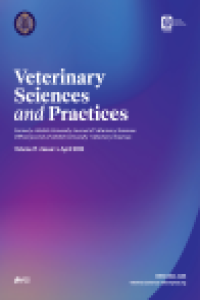Bir Kedide Perirenal Pseudokist
Bu çalışmada, unilateral perirenal pseudokist tanısı konan bir kedide klinik, radyolojik, patolojik bulguların ve gerçekleştirilen operatif sağaltımının sunulması amaçlandı. 5 yaşlı, erkek kedinin klinik muayenesinde sağ abdominal boşlukta palpe edilebilen bir kitle saptandı. Radyolojik tanısı amacıyla radyografi, ultrasonografi (US), renal Doppler ultrasonografi (DUS) ve ekskretuar ürografi (EU) yapıldı. Perirenal pseudokistin radyolojik tanısı laparatomi sırasındaki gözlemlerle ve histopatolojik incelemelerle kesinleştirildi. Kistik oluşum, kapsülü ile birlikte ekstirpe edildi ve sağ böbrek nefrektomi yapılarak uzaklaştırıldı. Sonuç olarak; sporadik olarak karşılaşılan perirenal pseudokist olgularında renal fonksiyonun değerlendirilmesinin önemli olduğu; EU ve renal DUS’nin perirenal pseudokist tipinin, renal fonksiyonun ve renal hasarın değerlendirilmesinde katkı sağlayacağı kanısına varıldı.
Anahtar Kelimeler:
Kedi, Ekskretuar Ürografi, Perirenal pseudokist, Renal Doppler Ultrasonografi
Perirenal Pseudocyst in a Cat
This study described clinical and radiological evaluations and pathological findings as well as surgical treatment in a cat diagnosed with unilateral perirenal pseudocyst. In a 5‐year old cat, a palpable cyst in the right abdominal cavity was suspected upon clinical examination. Perirenal pseudocyst of radiological diagnosis to confirm the mass included radiography, ultrasonography (US), renal Doppler ultrasonography (DUS), and excretoryurography (EU). Together with radiological findings, observations during laparatomy, and histopathological findings revealed that the mass was a unilateral perirenal pseudocyst. The cyst with its capsule was extirpated and removed performing right renal nephrectomy. In conclusion, we consider that determination of renal function is important in cases of sporadically encountered perirenal pseudocyst that the EU and Doppler US needing to be performed in that context support one another in determining the type of perirenal pseudocyst, renal function and renal damage.
___
- Abdinoor DJ., 1980. Perinephric pseudocysts in a cat. J Am. Anim. Hosp. Assoc., 16, 763‐767.
- Geel JK., 1986. Perinephric extravasation of urine with pseudocyst formation in cat. J. S. Afr. Vet. Assoc., 57, 33‐34.
- Hawe RS., 1991. What is Your diagnosis? Bilateral perirenal cysts. J. Am. Vet. Med. Assoc., 198, 471‐4721.
- Inns JH., 1997. Treatment of perinephric pseudocyst by omental drainage. Aust. Vet. Pract., 27, 174177.
- Kirberger RM., Jacobson LS., 1992. Perinephric pseudocsts in a cat. Aust. Vet. Pract., 22, 160163.
- DiBartola SP., Westropp J., 1997. Perinephric pseudocysts, Ed: August JR., Consultations in Feline Medicine III. Saunders. Philadelphia, 341344.
- Beck JA., Bellenger CR., Lamb WA., Churcher RK., Hunt GB., Nicoll RG., Malik R., 2000.
- Perirenal pseudocysts in 26 cats. Aust. Vet. J., 78, 166‐171. Lemire TD., Read WK., 1998. Macroscopic and microscopic characterization of uriniferous perirenal pseudocyst in domestic short hair cat. Vet. Pathol., 35, 68‐70. Essman CS., Drost W., Hoower JP., Lemire TD., Chalman JA., 2000.
- Imaging of a cat with perirenal pseudocysts. Vet Radiol Ultrasound., 41, 329‐334.
- Davidson AJ., 1985. The Retroperitoneum. Ed: Davidson, AJ. Radiology of the Kidney. Philadelphi, 95‐124.
- Rishniw M., Weidman J., Hornof WJ., 1998. Hydrothorax secondary to a perinephric pseudocyst in a cat. Vet. Radiol. Ultrasound., 39, 193‐196. Kim W., Moon SO., Lee SY., Jang KY., Cho CH., Koh GY., Choi KS., Yoon KH., Sung MJ., Kim DH., Lee S., Kang KP., Park SK., 2006.
- COMP–Angiopoietin‐1 Ameliorates Renal Fibrosis in a Unilateral Ureteral Obstruction Model. J. Am. Soc. Nephrol., 17: 2474–2483.
- Heuter KJ., 2005. Excretory urography. Clin. Tech. Small. Anim. Pract., 20, 39‐45.
- Ruilope LM., Lahera V., Rodicio JL., Romero JC., 1994. Are renal hemodynamics a key factor in the development and maintenance of arterial hypertension in humans? Hypertension, 23, 3–9. Azar S., Johnson MA., Hertel B., Tobian L., 1977.
- Single‐nephron pressures, flows, and resistances in hypertensive kidneys with nephrosclerosis. Kidney. Int., 12, 28–40. Bander SJ., Buerkert JE., Martin D., Klahr S., 1985. Long‐term effects of 24‐hr unilateral ureteral obstruction on renal function in the rat. Kidney Int., 28: 614–620.
- McDougal WS., 1982. Pharmacologic preservation of renal mass and function in obstructive uropathy. J. Urol., 128: 418–421. Bude OR., Dipietro AM., Platt FJ., Rubin MJ., 1994.
- Effect of furosemide and intravenous normal saline fluid load upon the renal resistive index in nonobstructed kidneys in children. J. Urol., 151, 438‐441. Sarı A., Dinç H., Zıbandeh A., Telatar M., Güleme RH., 1999.
- Value of resistive index in patient with clinical diabetic nephropathy. Invest. Radio., 34, 718‐721.
- Platt JF., Rubin JM., Ellis JH., DiPietro MA., 1989. Duplex Doppler US of the kidney: differentiation of obstructive from nonobstructive dilatation. Radiology, 171: 515–517
- Petersen LJ, Petersen JR, Talleruphuus U, Ladefoged1 SD, Mehlsen J., Jensen HE., 1997. The pulsatility index and the resistive index in renal arteries. Associations with long‐term progression in chronic renal failure. Nephrol. Dial.Transplant.,12: 1376–1380
- Platt JF., 1992. Duplex Doppler evaluation of native kidney dysfunction: obstructive and nonobstructive disease. Am. J. Roentgenol., 158: 1035‐1042.
- Rawahdeh YF., Djurhuus JC., Mortensen J., Horlyck A., Frokiaer J., 2001. The intrarenal resistive index as pathophysiological marker of obstructive uropathy. J. Urol., 165, 1397‐1404.
- Başlangıç: 2022
- Yayıncı: Atatürk Üniversitesi
